Voltage-Gated Ion Channels
Jim Hutchins
Objective 7: Summarize how voltage-gated channels are used to dynamically change the neuronal membrane potential.
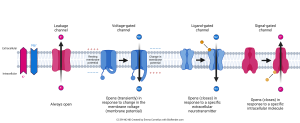
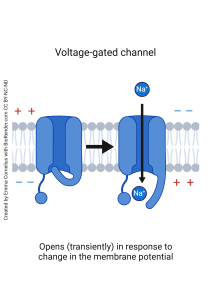
Remember that in Objective 1 we discussed the various types of ion channels found in neurons and other cells. In order to establish the basis for the resting potential, we examined leakage channels for potassium and leakage channels for sodium in Objective 3. Now we turn our attention from resting neurons to active neurons. Neurons become electrically active by opening or closing voltage-gated ion channels. In this Objective, we’ll consider voltage-gated potassium channels and voltage-gated sodium channels.
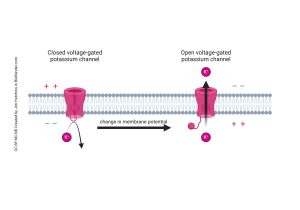
This diagram shows a voltage-gated potassium channel. The operation of these channels is relatively simple. When the voltage across the neuronal membrane changes, it causes the charges on amino acid –R groups to change; this, in turn, shifts the position of the amino acids and the protein changes shape. It can either be in an open configuration, as shown at left; or a closed configuration, as shown at right.
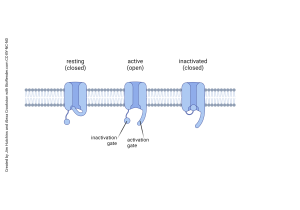
This diagram shows a simplified version of the three states of the sodium channel. Note that when the protein senses voltage, it operates one of two independent gates: the activation gate and the inactivation gate.
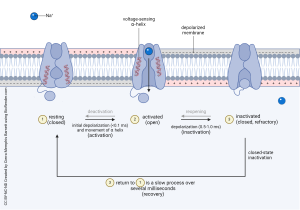
These two voltage-controlled gates operate on slightly different time scales, with activation gate being about 1 msec faster than the inactivation gate. Once it plugs the ion channel, the inactivation gate stays in place for about 2-3 msec on average. This means the voltage-gated sodium channel exists in one of three states, only one of which is open:
- the closed (resting) state: activation gate closed, inactivation gate open (channel closed)
- the open (activated) state: activation gate open, inactivation gate open (channel open)
- the inactivated (refractory) state: activation gate closed, inactivation gate closed (channel closed)
Resting state closed
Activated state open
Inactivated state closed

When a furnace is lined with bricks that are not damaged by high heat, we say those bricks are refractory.
When a significant number of voltage-gated sodium channels are in the inactivated state shown at the bottom of this cycle, then we say the membrane is refractory. That is, it is extremely difficult to depolarize the membrane because it’s almost impossible for sodium to flow into the neuron and make it more positive.
Media Attributions
- Ion Channels © Emma Cornelius is licensed under a CC BY-NC-ND (Attribution NonCommercial NoDerivatives) license
- Voltage gated channel © Emma Cornelius is licensed under a CC BY-NC-ND (Attribution NonCommercial NoDerivatives) license
- Voltage gated potassium channel © Jim Hutchins is licensed under a CC BY-NC-ND (Attribution NonCommercial NoDerivatives) license
- Three states of the voltage gated sodium channel © Jim Hutchins and Alexa Crookston is licensed under a CC BY-NC-ND (Attribution NonCommercial NoDerivatives) license
- Voltage Gated Sodium Channel Internal Gate Mechanisms Membrane Charges © Cierra Memphis Barnett is licensed under a CC BY-NC-ND (Attribution NonCommercial NoDerivatives) license
- Bricks © Unknown is licensed under a CC0 (Creative Commons Zero) license

